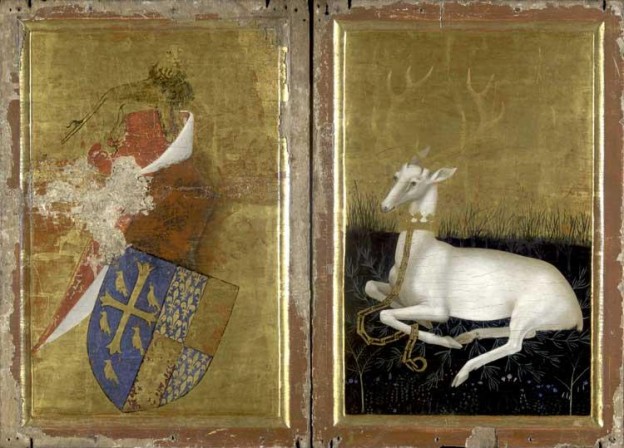For a while now, I’ve been meaning to write a bit about specific artworks and artists I think highly of, and I thought I’d start this new series with my favourite artwork of all time, The Wilton Diptych. Only about 21 inches x 14.5 inches in size when opened for display, but radiant well beyond its size, the work is actually a folding “portable” altarpiece comprising 4 paintings in total. The two paintings on the inside make up one continuous picture (the “diptych” referred to in its title), while the final two paintings serve as decoration for the front and back “covers” of the work. Most likely painted at the end of the 14th century (circa 1395-1399), the work was created for King Richard II of England around the time he was about 11 years old.
Done in gold leaf and tempera on two oak panels, the diptych is an stellar example of pretty much every aspect of art-making. The draftsmanship, brushwork, craftwork with the gold, and execution of detail are all mind blowing. The inside panels depict a young King Richard being presented to The Virgin Mary and Child, surrounded by angels. On the left we see Richard kneeling, surrounded by his presenters John the Baptist, Edward the Confessor, and Edmund the Martyr (I admit I had to look him up). On the right hand side, we see the Virgin holding the Child in her hands as he appears to reach out to Richard, the two of them surrounded by angels. The outside panels show coats of Arms on one side, and a white hart (stag) on the other. This last panel is my personal favourite, The white stag (Richards symbol) sits on a field of black grass. He wears a collar of gold (actually just an unpainted negative space) that blends into the gold leaf background, as do the delicately painted horns on his head. After seeing every major museum in the world, this panel is still hands down my favourite.
When I first saw the Wilton Diptych, medieval art and religious art weren’t my default favourites, and I think that’s what really got me about this piece. Like all masterpieces, it’s so beautiful that it transcends any intent or ideology that went into making it, and even its own physical nature as an object, and becomes a completely self-defining thing. A sum much greater than the whole of its parts.
Another kind of cool thing about the Wilton Diptych is that nobody knows who painted it. People sometimes attribute it to “The Wilton Master”, but no one knows who that is. Based on it’s stylistic characteristics, it’s generally thought the artist was French, and that he perhaps had experience working with illuminated manuscripts, due to the intricacy of the detail and the gold work. Some people are also confused by the name, which has nothing to do with Richard the II. The Wilton Diptych gets it’s name from the Wilton House in Wiltshire (home to the Earls of Pembroke for centuries), where it spent a large portion of it’s life before being purchased by the National Gallery in 1929, but it’s history is much deeper than that. If you’d like to read about the panel in great detail, the best place to find all of the info is actually here on Wikipedia. And of course, you can still find this tiny masterpiece sitting deep inside the National Gallery in London, waiting for you to come and check it out. It’s worth a trip to London just to see it in person.


